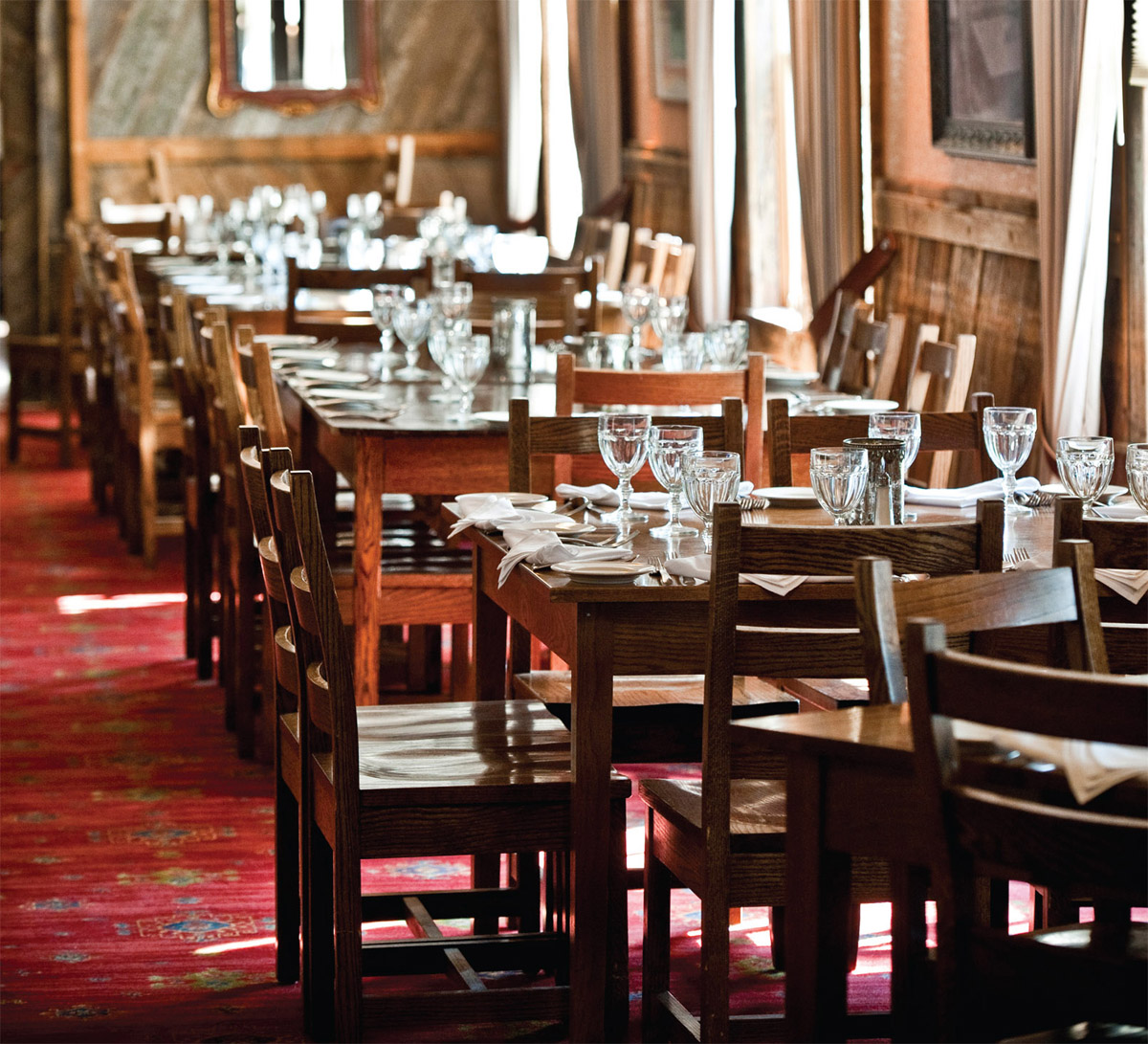

AT THE HEART OF THE TABLE and the ultimate expression of a “western kitchen” are the main dishes at Chico. Reaching back to classic European roots (think beef Wellington and Grand Marnier duck) as restaurant hallmarks and stretching the boundaries to define “regional” cuisine, we offer contemporary twists on the menu. That means spices, herbs, ingredients, and techniques that range from Asia to Latin America to backyard grilling to a farmer’s field that we drive by every day on the way to work.
Note: Recipes denoted by  are Chico “Classics.”
are Chico “Classics.”
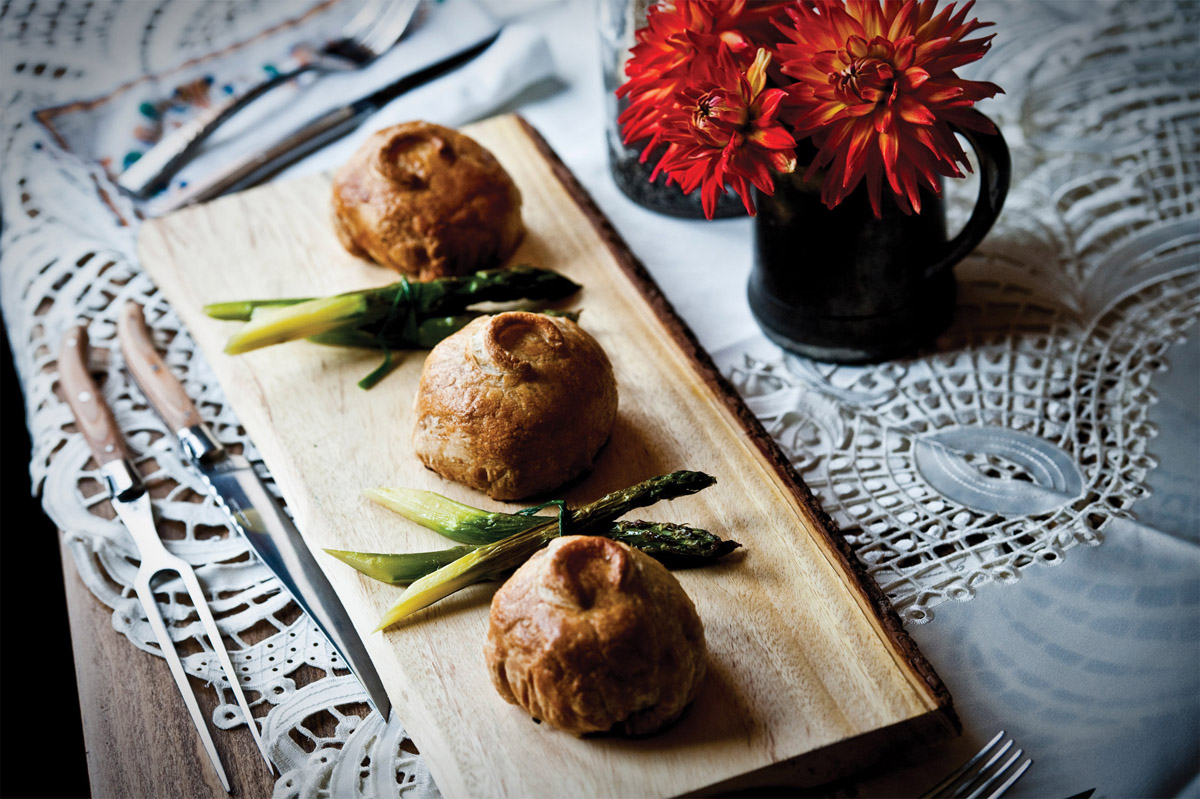
CHEF’S TIP
For elegant small plates, the beef Wellington can be prepared as individual 2-ounce portions to make eight servings. To adapt the recipe, sear the whole tenderloin as directed and let cool. Once it is cool, cut meat into 2-ounce squares. Cut puff pastry into eight 4-inch squares (this may require a second sheet) and wrap each piece of meat individually. Bake at the same temperature for 20 to 25 minutes, monitoring with a meat thermometer.

This traditional English recipe is an elegant and decadent dinner. Beef tenderloin is layered with earthy duxelles, then wrapped in a buttery puff pastry, and is so rich that it barely needs accoutrements. In Chico’s historic dining room, this signature dish is prepared for two, carved tableside, and served with au jus.
SERVES 4
Ingredients
FOR THE BEEF:
1 pound beef tenderloin, trimmed
½ tablespoon sea salt
1 tablespoon black pepper
1 tablespoon canola oil, plus more for coating baking pan
FOR THE DUXELLES:
2 tablespoons unsalted butter
2 tablespoons finely diced shallot
2 cloves garlic, minced
1 cup finely diced cremini mushrooms
½ cup white wine
FOR THE PASTRY:
1 (10 × 15-inch) puff pastry sheet, thawed
1 egg
Instructions
TO PREPARE THE BEEF TENDERLOIN:
Trim the fat and muscle off each tenderloin unless your butcher has already done so. Season the trimmed tenderloin with salt and pepper. Heat oil in a large skillet over high heat until almost smoking; sear meat until brown on all sides. Remove from pan and let cool.
Preheat oven to 375°F. Coat a baking pan with oil and set aside.
TO PREPARE THE DUXELLES:
Duxelles are a French mixture of lightly sautéed mushrooms and aromatics. In a medium sauté pan melt butter and sweat with shallots and garlic. Add mushrooms and sweat as well. Add wine and simmer over low heat until liquid is almost completely reduced. Let cool.
TO PREPARE THE WELLINGTON:
Lay puff pastry sheet on a clean, flat surface. Spread the duxelles in the center of the pastry in an area that is the same size as the tenderloin. Place meat on top of the duxelles. Fold in sides of pastry to enclose tenderloin like a present. Tuck the corners of the pastry inside, smoothly pressed against the meat. Set on the oiled baking pan, fold-side down.
Crack the egg in a bowl and whisk with a fork. Brush egg wash over the pastry. Place in the preheated oven and bake for 30 to 40 minutes for medium rare. Use a meat thermometer to check temperature; puff pastry should be golden brown when done. Remember that the pastry-wrapped meat will continue to cook even after it is removed from the oven, so it’s best to undercook by about 5°F.
When Wellington is cooked to desired temperature, remove from the oven and let rest for 10 to 15 minutes. Slice into four portions and serve with Duchesse Potatoes (recipe page 89), grilled asparagus, or your favorite side dishes.

CHEF’S TIP
This recipe is represented as an entree here, but it can easily be prepared as an appetizer by cutting the halibut fillets into smaller 3-ounce pieces to serve eight people. When cooking smaller pieces, be careful not to crowd the pieces in the pan during browning. Reduce oven time, baking 5 to 8 minutes instead.
 with Port Wine Butter Sauce and Mango Salsa
with Port Wine Butter Sauce and Mango SalsaThis longtime favorite is a famous example of Chico’s style of “layering” flavors. Here, with fresh halibut flown in twice a week, we offset the flaky white fish with a heavy coating of pine nuts and a deep buttery sauce. A crisp fruit salsa lightens up the ensemble. Traditionally we splurge on mango, but other seasonal fruits are an acceptable substitute. Strawberries and melons work nicely too. This recipe also works with other firm, white fish, such as sole. The port wine butter sauce cannot be reheated or chilled, so prepare it while the halibut is in the oven or just before serving.
SERVES 4 (MAKES 2 CUPS MANGO SALSA)
Ingredients
FOR THE PINE NUT CRUST:
2 cups pine nuts
¾ cup bread crumbs
1 teaspoon salt
⅓ cup parsley
FOR THE HALIBUT:
½ cup all-purpose flour
1 cup buttermilk
4 (6-ounce) halibut fillets
1 teaspoon olive oil
FOR THE PORT WINE BUTTER SAUCE:
2 cups port wine
½ cup heavy whipping cream
½ cup (1 stick) unsalted butter
FOR THE MANGO SALSA:
1 mango, peeled, seeded, and diced
½ small red onion, diced
½ red bell pepper, diced
½ cup chopped chives
3 tablespoons raspberry vinegar
2 tablespoons honey
2 tablespoons chopped cilantro
Instructions
TO PREPARE THE PINE NUT CRUST:
In a food processor combine all ingredients. Pulse until nuts are diced, but not too finely; remove and set aside. You can also prepare the crust by hand. Be sure to dice the nuts before combining with the other ingredients.
TO PREPARE THE HALIBUT:
Preheat oven to 400°F. Place flour, buttermilk, and pine nut mixture in separate bowls and arrange in a line on the counter. Take fillets and dip one side only in flour, then buttermilk, then pine nuts. On the stove heat a pan with 1 teaspoon olive oil and, with crust-side down, sauté the fish until crust mixture is golden brown. Place the sautéed fish on a greased baking dish, bare fish-side down and bake in the oven for 8 to 10 minutes.
TO PREPARE THE PORT WINE BUTTER SAUCE:
This sauce cannot be reheated or chilled, so prepare it while the main course is in the oven or just before serving. Reduce port over medium heat until it forms a syrup and coats a metal spoon, about 20 minutes. Add cream and reduce until thick. Remove from heat and add butter, stirring constantly until butter is melted and sauce is smooth. Turn heat down to low and use promptly.
TO MAKE THE MANGO SALSA:
Mix all ingredients in a bowl and refrigerate until needed.
TO PLATE:
Serve the halibut in a pool of port wine butter sauce, topped with the fresh mango salsa.
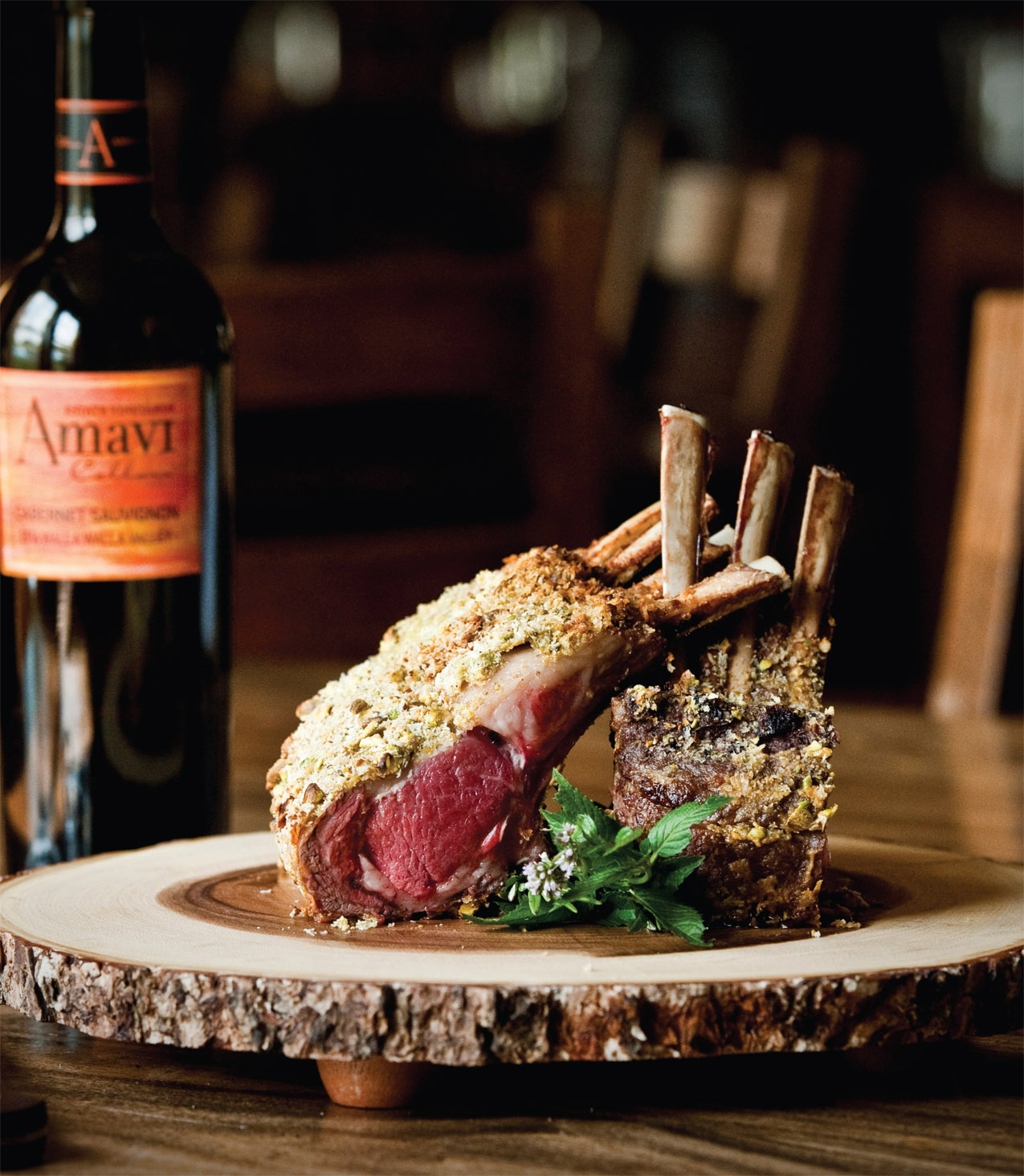
Bringing the offerings of local ranches to the table, here the gamey flavors of lamb epitomize Montana’s grassy foothills. Paired with a medley of herbs and pistachios, the meat is encrusted in a crunch that enhances the juicy tenderness of this entree.
SERVES 4–8
Ingredients
2 tablespoons canola
1½-pound rack of lamb
½ cup panko bread crumbs
½ cup chopped pistachios
½ teaspoon chopped fresh rosemary
2 tablespoons chopped fresh parsley
1 teaspoon chopped fresh sage
1 tablespoon chopped fresh thyme
2 tablespoons Dijon mustard
Instructions
In a cast-iron skillet or heavy-bottomed pan with heated canola oil, sear lamb and let cool. Combine panko and pistachios with herbs. Rub lamb with mustard, then dip into pistachio-panko mixture, pressing on all sides to form a crust. Bake at 375°F for 30 to 40 minutes, depending on the size of the rack, for medium temperature. Remove from the oven and let the rack rest on a cutting board for 10 minutes to seal in the cooking juices. Slice and serve with your choice of savory sides. This would pair well with Roasted Fingerling Potatoes and Sautéed Kale (recipe page 95).
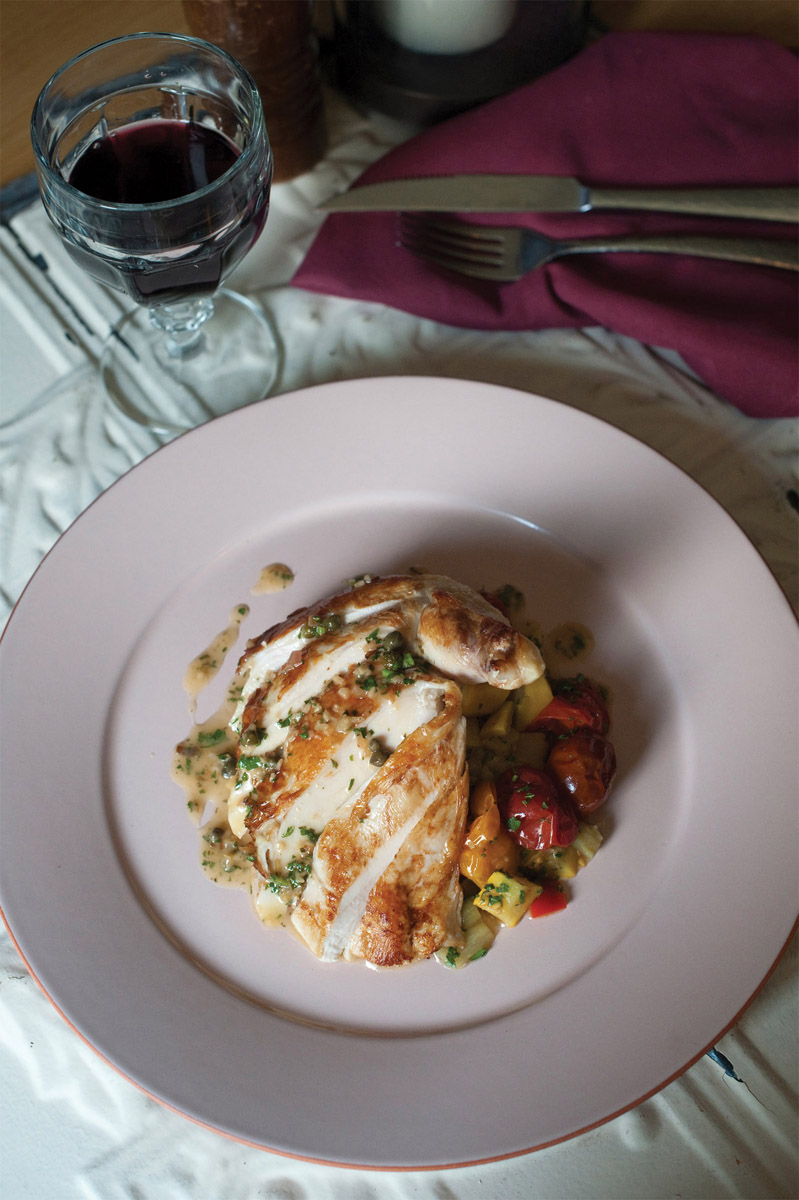
CHEF’S TIP
Be cautious not to add too much salt to the veloute sauce since the brined chicken is already saturated with the ideal amount of salt.
This is not your plain-old Wednesday night chicken dinner! The process of brining, searing, and roasting creates the crispiest skin paired with meat that is moist and packed with tangy flavor. Take the time to make the veloute sauce and you will be creating an unforgettable chicken dinner. For best results, brine chicken and make the stock one day ahead.
SERVES 2–4
Ingredients
FOR THE CHICKEN AND BRINE:
4 cups water
2 bay leaves
1 tablespoon peppercorns
1 lemon, halved
⅓ cup kosher salt
1½ tablespoons fresh thyme
½ fresh rosemary sprig
1½ tablespoons fresh parsley
4 shallots, quartered
4 cloves garlic, smashed
2 cups ice
1 roasting chicken
FOR THE HERBED VELOUTE SAUCE:
1 tablespoon olive oil
1½ cups julienned leeks
4 tablespoons unsalted butter
½ cup all-purpose flour
4 cups chicken stock
1 tablespoon minced fresh parsley
1 tablespoon minced fresh Instructions
thyme
1 teaspoon minced fresh sage
½ teaspoon minced fresh rosemary
1 tablespoon lemon juice
Pinch of salt
Instructions
TO BRINE THE CHICKEN:
Put all ingredients, except ice and chicken, in a saucepan and bring to a boil. Simmer for 5 to 10 minutes. Remove from heat and add ice. Put in the refrigerator to cool.
Meanwhile, break down a whole fryer chicken by removing the breasts and deboning the thighs, keeping drumsticks and skin intact. Place the chicken pieces in the cooled brine; keep submersed 6 hours or overnight. Reserve wings, carcass, and giblets to make Chicken Stock (recipe page 184).
TO MAKE THE HERBED VELOUTE SAUCE:
In a saucepan over medium-low heat, sweat leeks in olive oil. In a separate pan, melt butter and whisk in flour to make a roux. When leeks are translucent, add chicken stock and bring to a boil. Whisk in roux thoroughly to eliminate any lumps. Reduce heat to a simmer. Simmer until thickened. Add herbs, lemon juice, and a pinch of salt.
TO ROAST THE CHICKEN:
Preheat oven to 350°F.
Remove breasts, thighs, and drumsticks from brine. Rinse and pat dry.
Heat a large cast-iron skillet over medium-high heat, adding just enough canola oil to cover the bottom. When pan is hot, add chicken skin-side down, one piece at a time, to keep the pan temperature consistent. Sear until skin is crispy and golden brown. Remove and place on a plate to hold until all chicken is seared. You may need to add more oil between searing; allow the pan oil to heat again before cooking another piece of chicken. Turn the pieces over and place skin-side up in the skillet. Roast in the oven for around 15 minutes until chicken is cooked through.
Serve with herbed veloute sauce and your favorite seasonal accompaniments.

 with Port Wine Sauce
with Port Wine SauceMontana is famous for its beef, and Chico uses certified Angus cuts for slice-like-butter tenderness. The combination of herbs in this recipe brings out the natural, rich flavors of the filet, while the sauce deepens the savory result.
SERVES 4 (MAKES APPROXIMATELY 1 CUP SAUCE)
Ingredients
FOR THE PORT WINE SAUCE:
1½ cups port wine
1 cup sweet vermouth
½ cup granulated sugar
FOR THE STEAKS:
¼ cup fennel seeds
¼ cup whole coriander seeds
1 teaspoon salt
1 teaspoon black pepper
4 (8-ounce) beef tenderloin steaks
4 tablespoons crumbled Gorgonzola cheese
Instructions
TO MAKE THE PORT WINE SAUCE:
Combine ingredients in a small saucepan. Reduce over medium heat until the mixture forms a syrup, about 30 minutes. When it coats a spoon, the sauce is done. It can be made the day before and will keep in the refrigerator for up to a week. Warm over low heat when ready to serve.
TO MAKE THE STEAKS:
In a spice grinder or blender, pulse fennel and coriander seeds, salt, and pepper until coarsely ground. Roll outer edge of each steak in herbs to form a crust; do not encrust cut ends. Grill each steak to desired temperature.
TO PLATE:
Warm port wine sauce in a saucepan. Ladle warm sauce onto individual serving plates, making a small pool slightly larger than the steaks; set the steaks on top of the sauce. Top with Gorgonzola cheese crumbles.
CHEF’S TIP
GRILLING RECOMMENDATIONS
• Rare 2 to 4 minutes on each side
• Medium rare 6 to 8 minutes on each side
• Medium 10 to 12 minutes on each side
• Medium well 14 to 18 minutes on each side
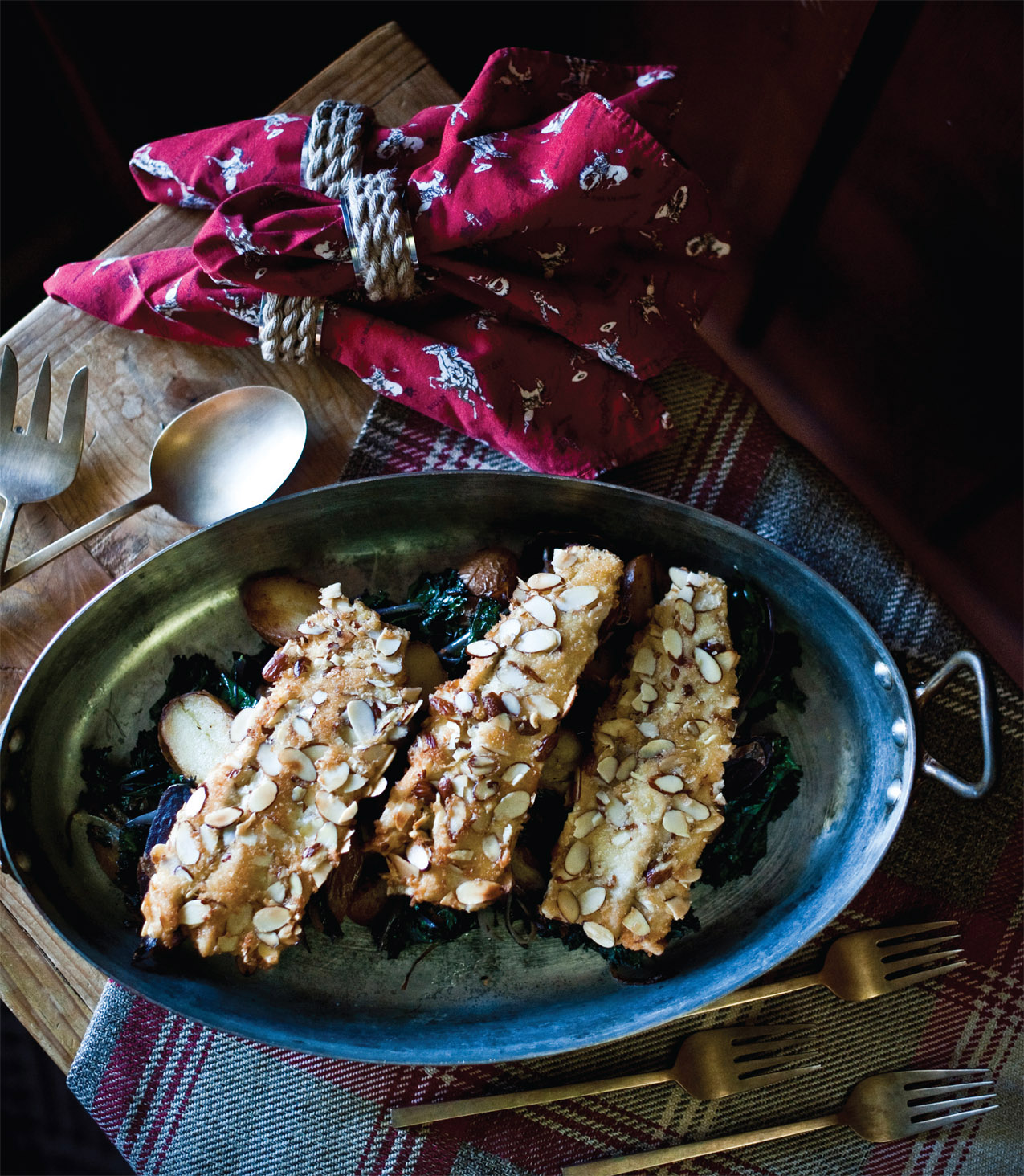
Locally caught trout benefits from the simple preparation and nutty crust of this recipe. It goes well with the Roasted Fingerling Potatoes and Sautéed Kale (recipe page 95). To serve, place the potato mixture in the middle of each plate, top with one or two sides of trout, and drizzle with remaining clarified butter.
SERVES 4–8
Ingredients
2 cups panko bread crumbs
1 cup almond slices
8 sides of trout (4 fish), deboned with skin on
1 cup clarified butter, divided
Instructions
For the crust, combine panko and almonds in a shallow bowl. Press trout fillets to coat each side for the breading. In a large sauté pan or cast-iron skillet, add 2 tablespoons of clarified butter and warm over medium heat. Cooking two pieces at a time, place trout skin-side down and brown for 3 to 4 minutes, then flip and cook the other side for another 3 to 4 minutes until crust is toasty brown and fish is flaky. Remove from the pan and set aside on a warmed plate. Repeat with remaining sides of trout, adding more butter each time.
Hold in a warm oven while preparing kale and roasted potatoes.
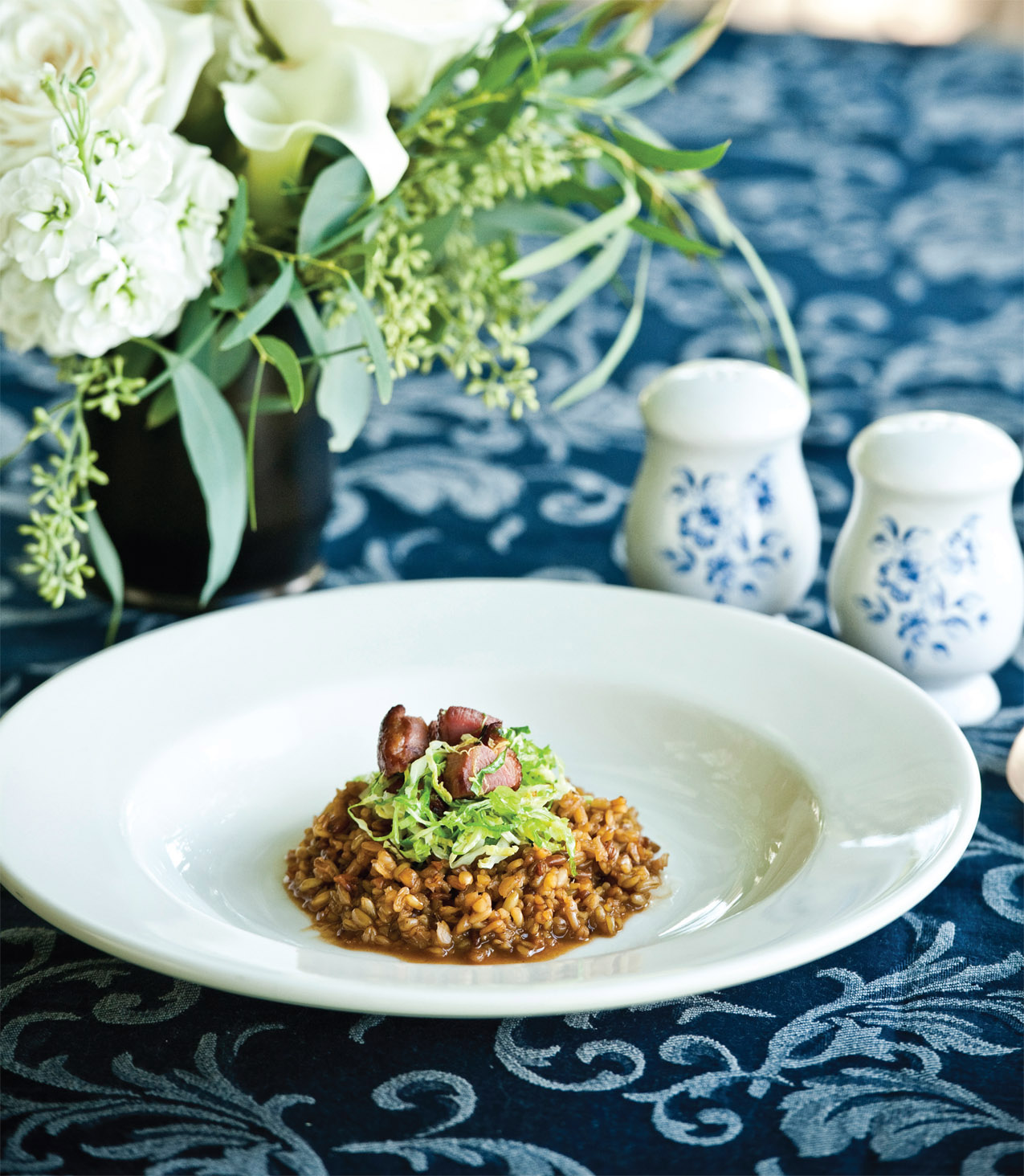
Farro is an ancient relative of wheat, and the heirloom grain is still favored in Italy for its chewy texture and rich, nutty flavor. Our farro is Montana grown by Timeless Seeds, Inc. This dish takes about twenty minutes to cook at a simmer and makes a great vegetarian entree without the pancetta and with the substitution of vegetable stock.
SERVES 6
Ingredients
¼ cup diced shallot
1 tablespoon canola oil
3 cups farro (semi-pearled variety)
1 cup white wine
2 cups chicken or vegetable stock
2 tablespoons unsalted butter
Salt to taste
4 cups brussels sprouts
1¼ cups diced pancetta (optional)
¼ cup apple cider vinegar
Instructions
Sweat shallots in 1 tablespoon canola oil. Add farro and deglaze with white wine. Simmer over low heat, stirring often. Add chicken or vegetable stock a little at a time as the farro hydrates. Cooking time is approximately 20 minutes. Finish with butter and salt to taste.
Trim stems from brussels sprouts and shave thin slices on a mandoline or food processor. In a skillet, render the pancetta over low heat until crisp. Add a little canola if needed, then turn up heat to medium high. Add brussels sprouts and quickly caramelize, being careful not to overcook. Deglaze with cider vinegar, then add salt to taste. Brussels should be al dente.
To serve, spoon cooked farro into shallow bowls and top with brussels sprouts and pancetta.
During the mid-1970s Chef Larry Edwards perfected a Duck L’Orange that became a staple of the Chico menu. With a twist and a nod to this dish’s French origins, Chef Dave Wells improved this classic with a preparation of the duck in two different ways: confit and a crisply seared breast. The most challenging aspect of this recipe is the Grand Marnier sauce; it requires several hours to prepare. Make the sauce one or two days in advance for best results.
SERVES 4
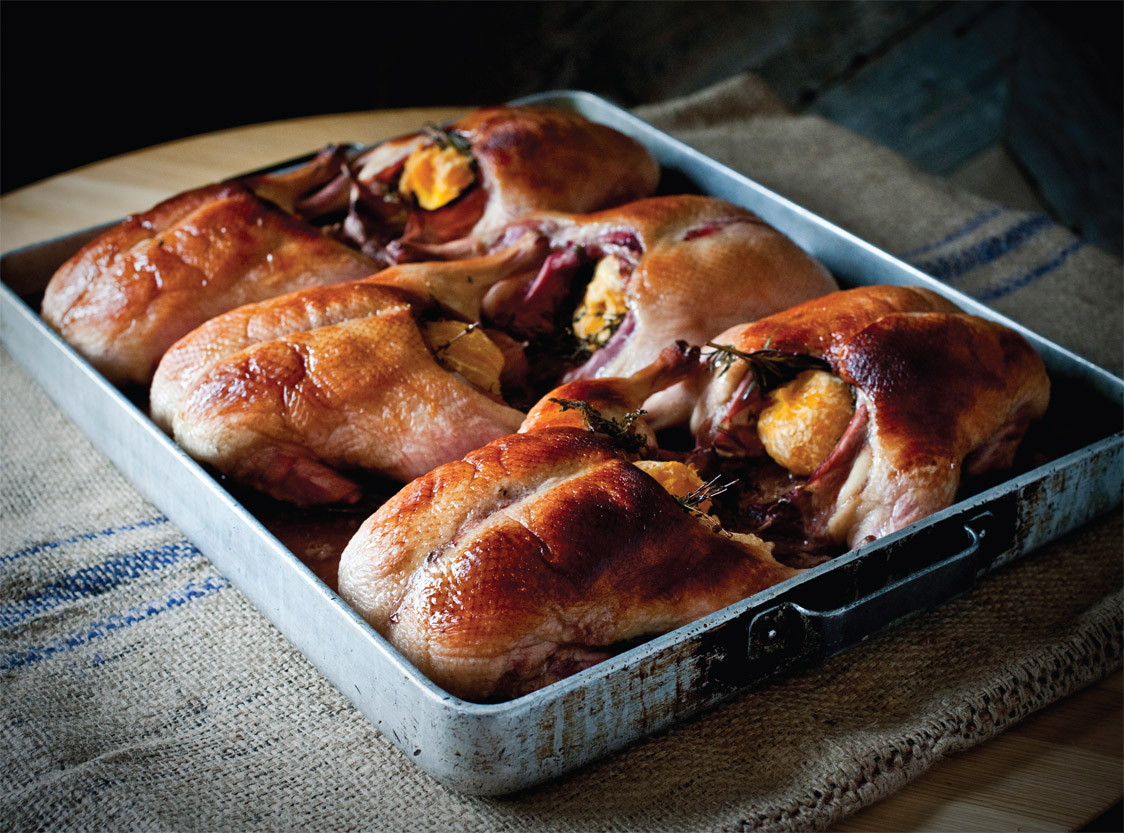
Ingredients
FOR THE DUCK:
1 whole Pekin duck
4 celery stalks
2 medium-large carrots, peeled
2 large onions
1 tablespoon tomato paste
Bouquet garni (1 sprig fresh sage, 2 bay leaves and 3 sprigs fresh thyme wrapped in kitchen string)
1 tablespoon chopped fresh thyme
1 tablespoon chopped fresh parsley
1 cup kosher salt
1¼ teaspoons juniper berries, ground
1 cup rendered duck fat
6 thyme sprigs
4 parsley sprigs
2 cloves garlic
FOR THE GRAND MARNIER SAUCE:
2 quarts Duck Stock (recipe page 185)
¼ cup Grand Marnier liqueur
Zest and juice from 1 orange
Salt to taste
Instructions
TO PREPARE THE DUCK:
Start by breaking the carcass down. Remove the breasts and legs, then trim the carcass of all fat. Place fat in a saucepan and render over low heat. Trim the carcass of all excess meat; reserve for later use. (Be thorough, as the trim from this can be used for the Cornish Game Hen Ballotine recipe, page 55; freeze if desired).
Preheat oven to 400°F. To make a mirepoix, rough chop celery and carrots, quarter the onions, and rub with tomato paste. Place mirepoix on a sheet pan along with the duck carcass. Roast in the oven until browned. Place mirepoix and duck carcass in a stockpot and cover with cold water. Add bouquet garni and bring to a boil, then lower heat so water is barely simmering. Let simmer for 8 hours or overnight. Strain and reserve. This should yield about 1 gallon (4 quarts).
TO MAKE THE GRAND MARNIER SAUCE:
In a saucepan bring 2 quarts duck stock to a boil. Lower heat to a simmer. Let reduce slowly while skimming any impurities that float to the surface. Reduce to around 2 cups. Add Grand Marnier and zest and juice from the orange and reduce until sauce coats the back of a spoon. Salt to taste. This can be made the day before and refrigerated until ready to serve; warm over medium-low heat.
TO PREPARE THE CONFIT LEGS:
Mix the chopped herbs with the kosher salt and 1 teaspoon of ground juniper berries. Rub the duck legs with 2 tablespoons of the herb salt. Cover and place in the refrigerator for 8 hours.
Remove duck from refrigerator, rinse legs with water, and pat dry. Place legs in a baking dish just big enough to hold them both. Cover with rendered duck fat. Add thyme and parsley sprigs, remaining juniper berries, and garlic cloves. Cover and bake in a 250°F oven for 4 to 6 hours until tender. Let cool in fat and reserve. This can also be made a day ahead.
TO COOK THE DUCK BREAST AND SERVE:
Heat a pan over medium heat. Score the fat on the duck breasts, season with salt and place in pan skin-side down. Let fat render until the skin is crispy. Turn breasts over and sear. Cook to medium rare. Remove from pan and let rest for 10 minutes.
Meanwhile, add confit legs to the pan and sear until skin is crispy. Turn legs over and put in a 400°F oven until warmed through.
Slice breasts and serve with legs over Herbed White Beans (recipe page 91) with Braised Greens for Duck (recipe page 91). Drizzle with Grand Marnier sauce and enjoy.
The silky richness of coconut and the brightness of citrus in the sauce showcase the flaky, mild flavor of the halibut in Chef Dave Wells’s Thai-influenced fresh catch. The rice is a canvas for all the flavors, and the accent of a small garden salad adds the perfect amount of crisp texture.
SERVES 6
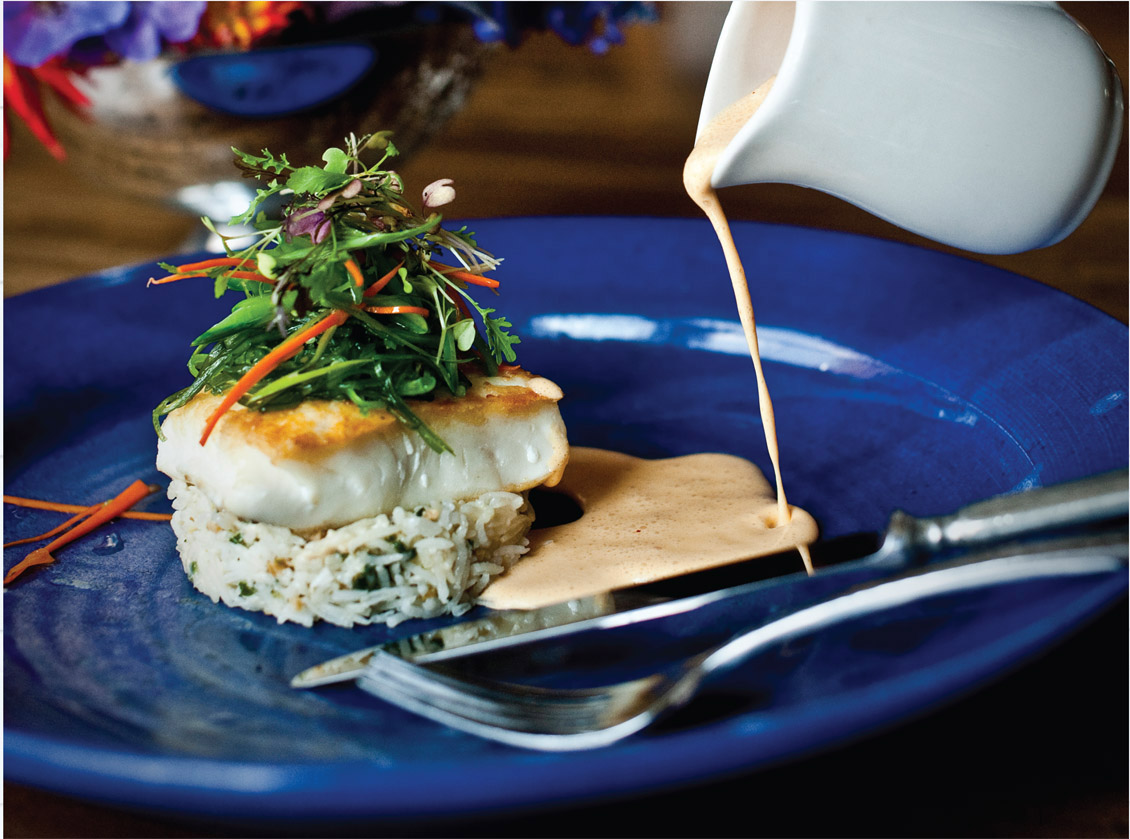
Ingredients
FOR THE CITRUS-COCONUT BROTH:
¼ cup diced shallot
3 cloves garlic, diced
1 teaspoon red curry paste
½ cup chopped lemongrass
3 cups coconut milk
Zest and juice of 1 lemon
Zest and juice of 1 lime
1 teaspoon fish sauce
1 teaspoon crushed red pepper flakes
1 tablespoon grated fresh ginger
FOR THE GINGER-SCALLION RICE:
3 cups basmati rice
4½ cups water
1 cup thinly sliced scallion
¼ cup minced fresh ginger
2 tablespoons mirin
½ teaspoon sesame oil
¼ cup tamari
1 teaspoon fish sauce
FOR THE CARROT AND SNAP PEA SALAD:
1 large carrot, peeled
1 cup snap peas
1 teaspoon tamari
1 teaspoon rice vinegar
FOR THE FISH:
2 tablespoons canola oil
2 pounds fresh halibut, cut into 6-ounce fillets
Instructions
TO MAKE THE CITRUS-COCONUT BROTH:
In a saucepan sweat shallots and garlic. Add curry paste. Stir and cook until fragrant. Add the remaining ingredients and reduce by a third. Strain through a fine-mesh sieve and keep warm in the saucepan until ready to serve.
TO MAKE THE GINGER-SCALLION RICE:
Rinse the rice well in cold water. Place in a saucepan with 4½ cups water. Bring to a boil, cover, and reduce to low heat. Cook for 15 minutes. While rice is cooking, in a mixing bowl add the scallions, ginger, mirin, sesame oil, tamari, and fish sauce and whisk until well combined. When rice is done, cover with a tea towel and let rest for 5 minutes. Fluff with a fork and fold in the scallion-ginger mixture.
TO ASSEMBLE THE SALAD:
Very finely julienne carrots and snap peas. Dress with tamari and rice vinegar. Set aside.
TO MAKE THE FISH:
Heat a large, oven-safe pan with canola oil over medium-high heat until it just begins to smoke. Add halibut to the pan and sear on one side, approximately 3 minutes depending on thickness of the fillets. Leave the fish in the pan and transfer it to a 350°F oven; cook until internal temperature is 140°F, approximately 5 minutes. Remove from oven.
TO ASSEMBLE THE DISH:
Spoon rice into a bowl and top with cooked halibut. Garnish the halibut generously with carrot-snap pea salad. Finally, pour a little citrus-coconut broth into a bowl and serve alongside the fish.
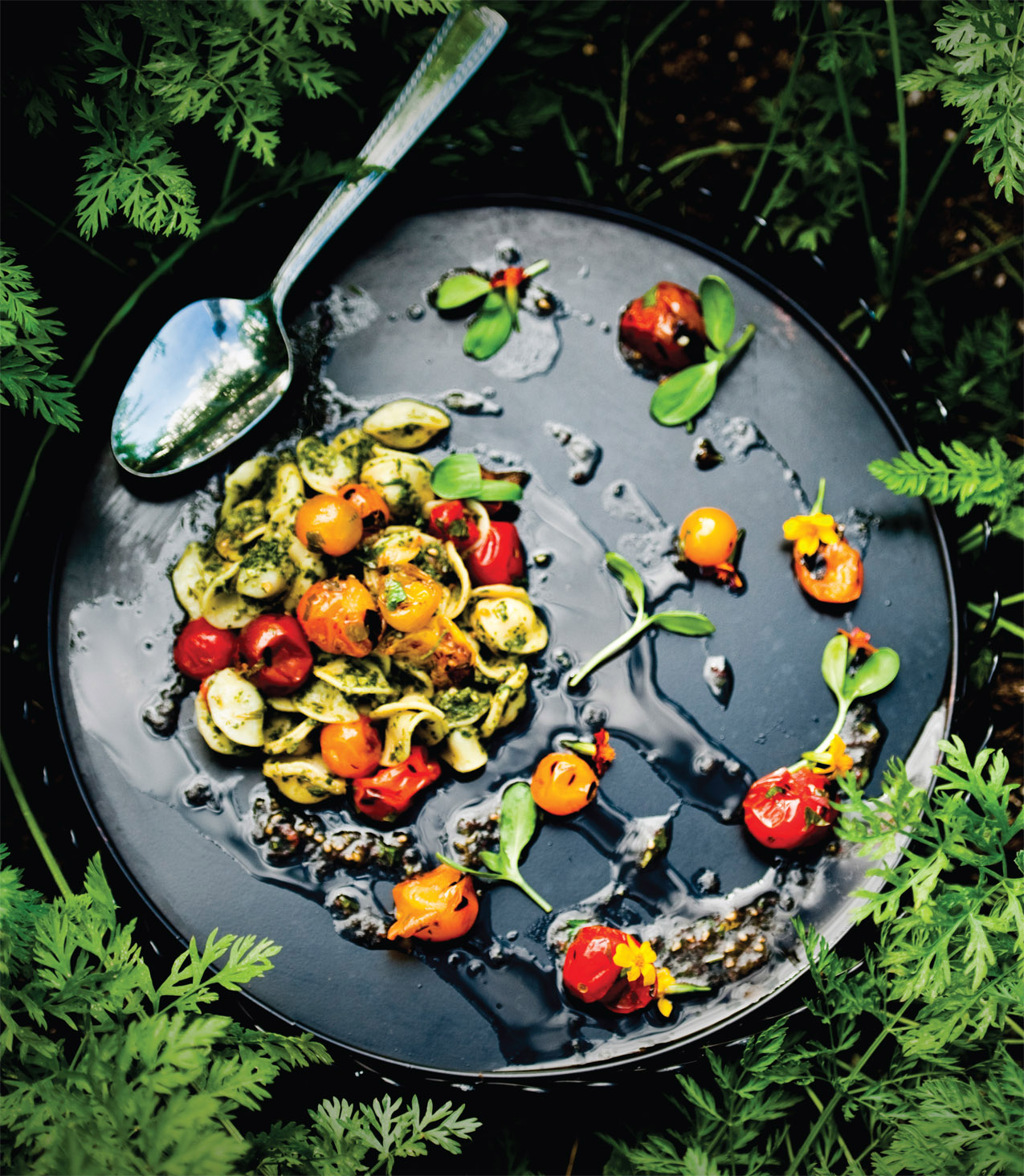
In the Chico greenhouse, head gardener Jeannie Duran cultivates at least five different varieties of little tomatoes—Little Gems, Sungolds, Cherry, Grape, and Pear. The ideal humid environment of the geothermally heated greenhouse produces a forest of tomato plants that grow to the ceiling and offer up a burst of color and flavor that is best consumed right off the vines. But next best is a quick-blistered version tossed with pasta and Chef David Wells’s carrot-top pesto.
SERVES 6
Ingredients
FOR THE CARROT-TOP PESTO:
2 cups packed carrot tops, stemmed
2 small cloves garlic
½ cup pine nuts
½ cup grated Parmesan cheese
4 tablespoons fresh lemon juice
Zest of 1 lemon
1½ cups olive oil
Salt and freshly ground black pepper to taste
FOR THE PASTA:
1 pound dry orecchiette pasta
8 cups salted water
FOR THE TOMATOES:
1 tablespoon olive oil
1 teaspoon minced garlic
3 cups grape or cherry or other small tomato variety
½ teaspoon kosher salt
1 teaspoon unsalted butter
Instructions
TO MAKE THE CARROT-TOP PESTO:
Place carrot tops, garlic, pine nuts, Parmesan, lemon juice, and lemon zest in a food processor or blender and combine until all ingredients are roughly chopped. Spoon into a bowl and fold in olive oil (if you process the oil, it becomes bitter) until well blended. Season with salt and pepper to taste.
TO MAKE THE PASTA:
Prepare orecchiette pasta by boiling salted water and cooking until al dente. Remove from heat, drain, and toss with pesto. Cover and set aside.
TO MAKE THE TOMATOES:
Heat the oil and garlic in a cast-iron skillet or heavy sauté pan over high heat until garlic is just softened, but not brown.
Carefully add the tomatoes and cook undisturbed for 1 minute. Stir gently and cook for another minute. Mix again and cook for 1 more minute, each time allowing the tomatoes to char or brown a bit and blister, but not break apart.
Remove the pan from the heat, gently toss with the salt and butter until the tomatoes are evenly coated.
TO SERVE:
Divide orecchiette with pesto into bowls, top with warm tomatoes, and serve immediately.
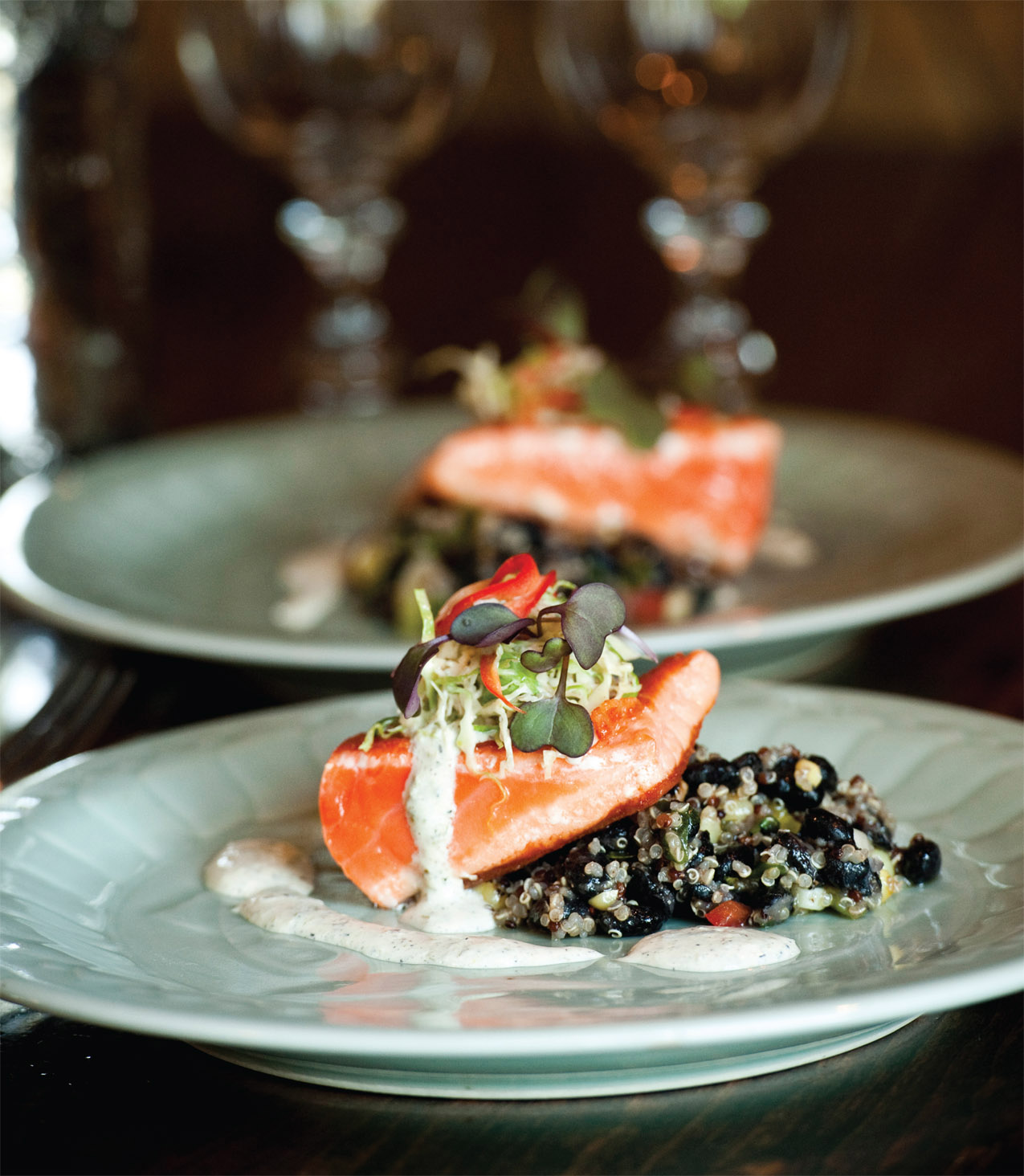
Layers of spice from the salsa and a touch of citrus from the Chipotle-Lime Slaw (recipe page 86) balance the oily fish, while the cream sauce adds a cooling finish to the palate.
SERVES 6 (MAKES 1 CUP CREMA)
Ingredients
FOR THE CHARRED SCALLION CREMA:
5 scallions
1 cup sour cream
FOR THE SALSA:
1½ tablespoons cumin
1½ tablespoons coriander
1 cup Smoked Corn on the Cob (recipe page 97)
2 cups cooked black beans
1 cup cooked quinoa
¼ cup chopped cilantro
½ red onion, fine diced
1 jalapeño, diced
⅓ cup apple cider vinegar
⅓ cup olive oil
FOR THE FISH:
2 tablespoons canola oil
6 (5-ounce) fresh Ora Salmon or wild king salmon fillets
Instructions
TO PREPARE THE CHARRED SCALLION CREMA:
Trim the ends off scallions. Using either a grill or a broiler, blacken the outer layer to a perfect char. Remove from heat and allow to cool. Once cool, finely chop scallions and mix with sour cream in a blender until smooth.
TO MAKE THE SALSA:
In a small pan over medium heat, toast the cumin and coriander. Let cool and grind in a spice grinder. Combine ground cumin and coriander with smoked corn, black beans, and cooked quinoa; mix well. Add cilantro, onions, jalapeño, vinegar, and oil, mixing again, and refrigerate until later.
TO COOK THE SALMON:
In a large sauté pan, heat canola over medium-high until barely smoking. Carefully add salmon and sear fillets for 3 minutes. Flip fillets and cook another 3 minutes until both sides are crisp, but barely browned.
TO SERVE:
Spoon approximately ¾ cup salsa onto individual plates and top with a seared salmon fillet, then garnish with a heaping spoonful of Chipotle-Lime Slaw (recipe page 86) and drizzle with charred scallion crema.
Inspired by Napa Valley’s famous Mustards Grill, the sweet, spicy, and caramelized elements of this hearty meal have become a Montana favorite at Chico. Grilling over low coals on the barbecue until the outside of the pork is perfectly charred (not burnt to bitter) is the secret to success.
SERVES 6
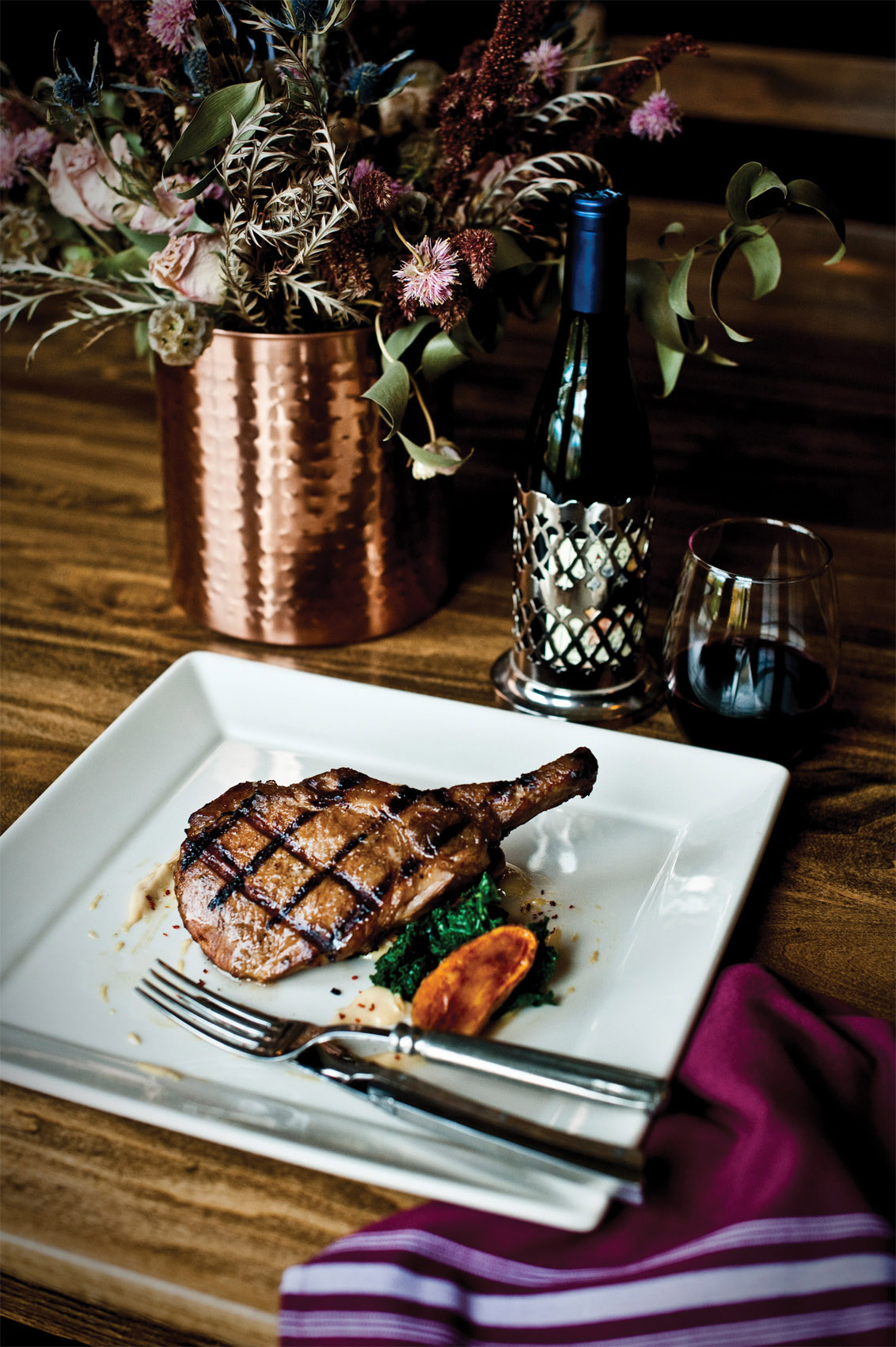
CHEF’S TIP
At Chico we use the sous vide method to prepare this thick-cut pork to the perfect and consistent medium temperature. At home, for even cooking, place your chops in a sealable plastic bag with a sprinkle of water inside to keep the bag from tearing and pound slightly with the smooth side of a meat mallet so that the thickness of each cut of meat is even. Marinate in the bag overnight if desired.
Ingredients
FOR THE PORK:
6 (10-ounce) center cut, bone-in pork chops, frenched
FOR THE MARINADE:
1 cup hoisin sauce (a Chinese black bean sauce; Lee Kum Kee is a reliable brand, but any premade option will work)
1 tablespoon brown sugar
1½ tablespoons tamari soy sauce
1½ tablespoons sherry
1½ tablespoons rice vinegar
1 scallion, minced
1 teaspoon Tabasco
1½ teaspoons minced peeled fresh ginger
1½ teaspoons minced garlic
¾ teaspoon freshly ground white pepper
¼ cup minced fresh cilantro leaves and stems
1 tablespoon sesame oil
FOR THE MUSTARD SAUCE:
½ cup granulated sugar
¼ cup mustard powder (such as Colman’s)
2 egg yolks
½ cup red wine vinegar
¾ cup crème fraîche or sour cream
Instructions
TO PREPARE THE PORK CHOPS:
To “french” the pork chops, trim the excess fat from the rib bones, leaving them exposed. Slightly tenderize the meat with a mallet to an even 1-inch thickness. Refrigerate and set aside.
TO MAKE THE MARINADE:
Combine all the ingredients in a bowl and mix well. Coat pork chops evenly and marinate for 3 hours or overnight in the refrigerator.
TO MAKE THE MUSTARD SAUCE:
Whisk sugar and mustard together in a metal mixing bowl. Place over a double boiler, whisking in egg yolks and vinegar. Cook over the simmering water for 10 to 15 minutes, stirring occasionally, until thickened. Remove from heat and allow the mixture to cool to room temperature. When cool, gently fold in the crème fraîche. The sauce can be kept refrigerated for 2 days before serving.
TO COOK:
Place the chops on a barbecue with coals settled to a medium heat/flame and grill for 5 minutes on each side for a medium temperature (139°F on a meat thermometer) or 8 minutes on each side for medium well. Brush excess marinade onto pork while grilling to enhance the caramelized flavors.
TO SERVE:
In the restaurant, the pork chop is served over Roasted Fingerling Potatoes and Sautéed Kale (recipe page 95) with a drizzle of the mustard sauce.
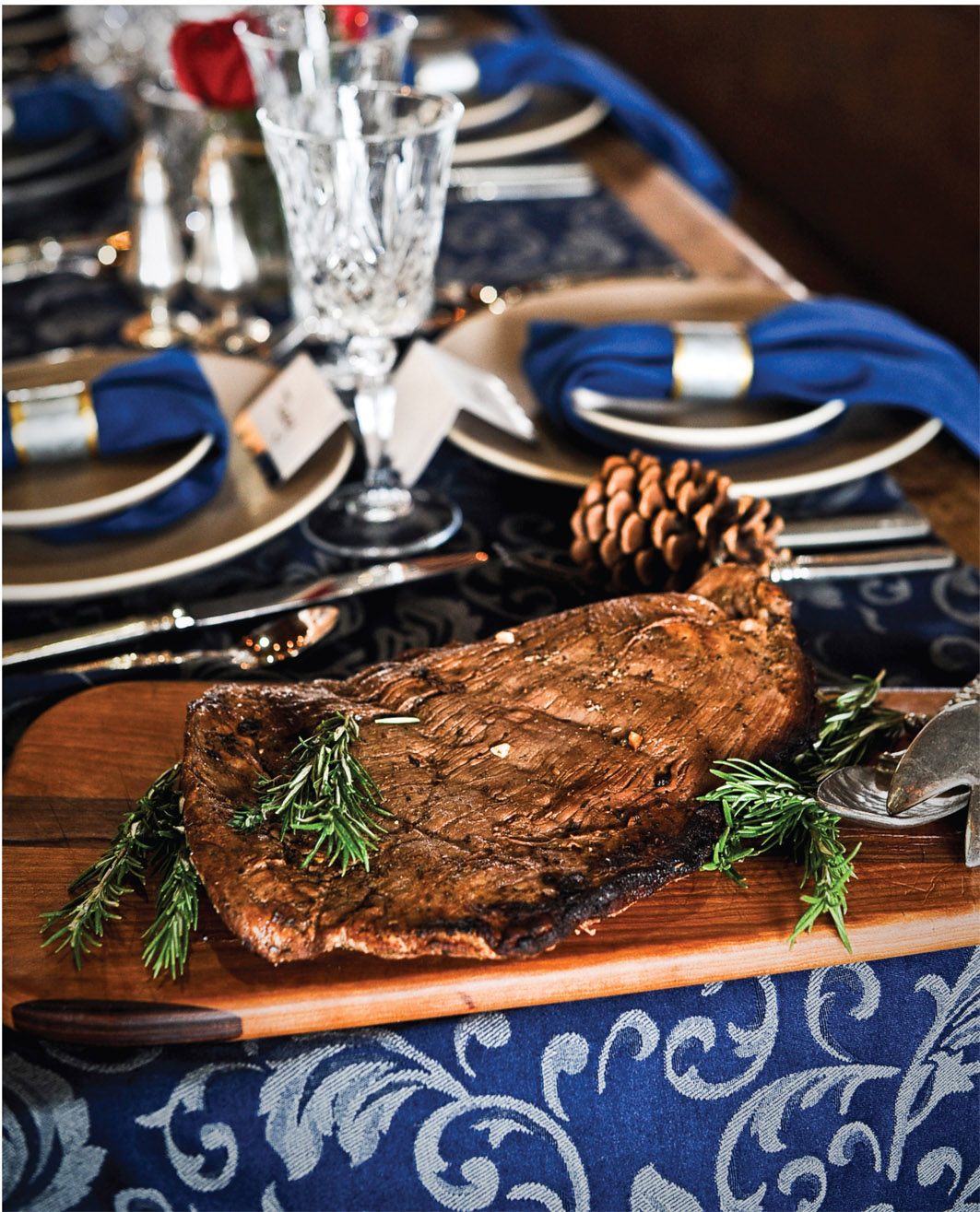
Hay butter, hay butter, hay butter! This is a real thing at Chico and quite likely invented by Chef Dave Wells, who brings out the tongue-in-cheek essence of Montana beef that was raised eating grass with this unforgettable hay-infused clarified butter that conjures summer and fresh-cut fields with every bite. It tastes like grass, but in a good way. Try it!
SERVES 4
Ingredients
FOR THE MARINADE:
¼ cup apple cider vinegar
2 tablespoons olive oil
3 large cloves garlic, minced
2 teaspoons Dijon mustard
2 teaspoons chopped fresh oregano
2 teaspoons Worcestershire sauce
2 teaspoons coarsely ground black pepper
FOR THE STEAK:
3 pounds flat iron steak (flank steak or hangar steak are acceptable substitutes)
Nonstick vegetable oil spray
1 cup Hay Butter (recipe page 187)
Instructions
TO MARINATE THE STEAK:
Combine the marinade ingredients in a large, nonreactive bowl. Place steak in the bowl and turn so that it is completely coated with the marinade. Chill and marinate for at least 2 hours and up to overnight.
TO GRILL THE STEAK:
Prepare barbecue (medium-high heat) or a cast-iron skillet sprayed with nonstick vegetable oil spray on the stovetop. Remove meat from marinade; discard marinade. Grill steak to desired doneness, about 4 minutes per side for medium rare.
When the steak has cooked to your preferred level of doneness, remove from the grill and place on a cutting board. Cover with aluminum foil to hold in the heat while the steak rests for 10 to 15 minutes.
TO SERVE:
Cut meat across the grain. Flat iron, flank, and hangar steaks can be tough and chewy unless you cut it in a way that breaks up the muscle fibers. So cut the steak at a sharp diagonal into thin slices. Liberally spoon hay butter over the top of the meat. Add a salad or sides of your choice, and serve with a little more of the hay butter for drizzling.
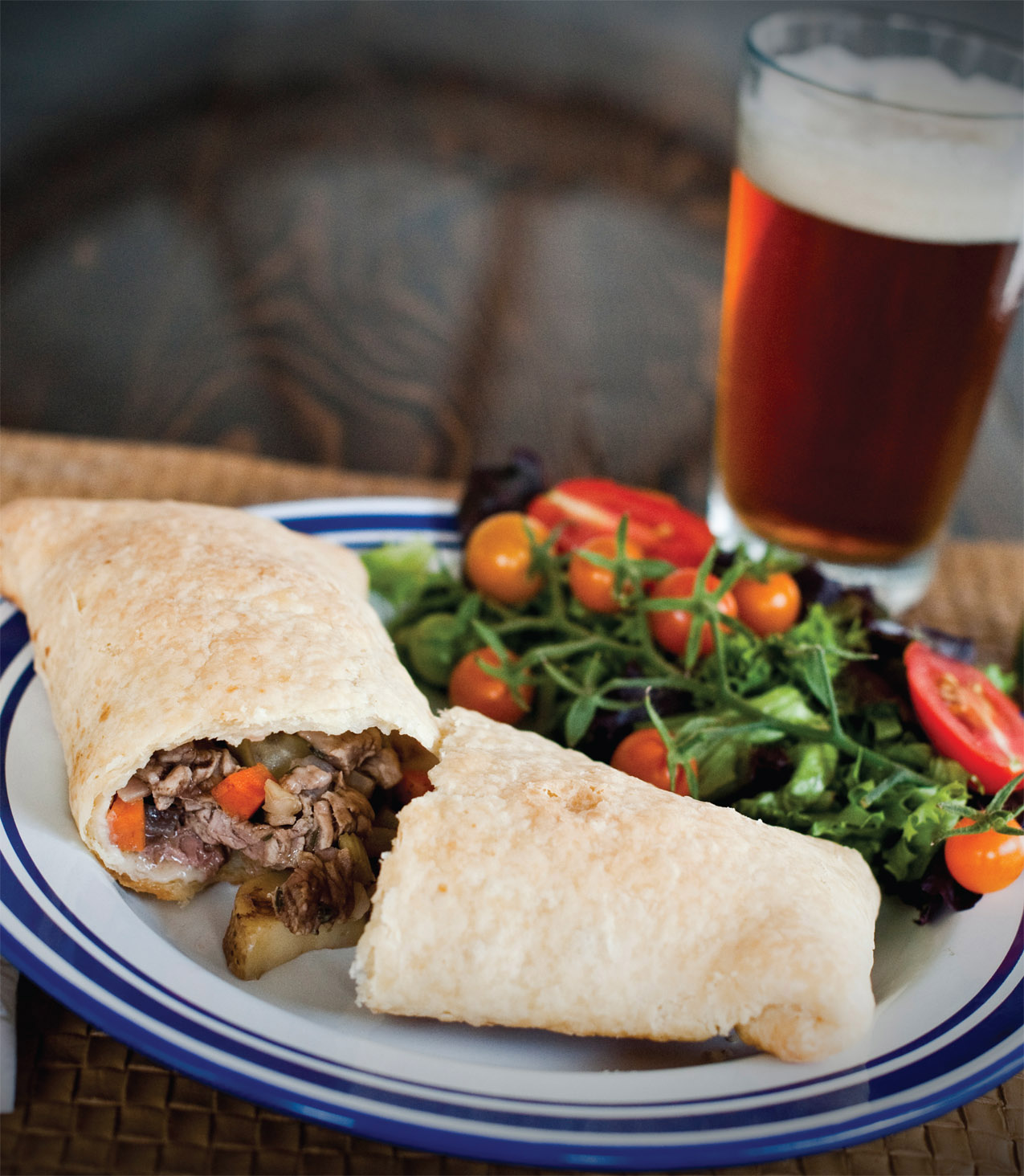
The pasty is a legacy from Cornish miners who immigrated to Butte, Montana, during the Copper King era. This homey meat pie is served as a casual meal in the Saloon and pairs nicely with a locally brewed Chico Amber.
SERVES 4
Ingredients
FOR THE CRUST:
1 batch Pie Dough, (recipe page 191)
1 egg, beaten
FOR THE FILLING:
2 tablespoons canola oil
1 small yellow onion, diced
1 large carrot, peeled and diced
1 rib celery, diced
1 tablespoon fresh thyme
4 cups cubed beef tenderloin
1 cup cubed fingerling potatoes
1 teaspoon kosher salt
¼ teaspoon black pepper
Instructions
Prepare Pie Dough (recipe page 191) and chill for an hour.
Meanwhile, in a skillet heat canola oil over medium. Sweat onion, carrots, celery, and thyme (mirepoix). When mirepoix is softened, add beef and potatoes. Cook until meat is lightly browned on all sides; add salt and pepper. Remove from heat and set aside to cool.
Preheat oven to 350°F. Divide the dough into four equal balls. On a lightly floured surface, roll each ball into a round about ¼ inch thick. Spoon beef and potato mixture into the center of the dough round, then fold pastry in half, tuck the top edge under the bottom edge, and seal by pressing with your fingers or marking with a fork. Repeat with all four rounds, then place on a buttered sheet pan. Brush liberally with the egg wash and bake for 45 minutes to 1 hour, until golden brown.
Serve warm with Mixed Greens with Orange-Ginger Vinaigrette (recipe page 84).
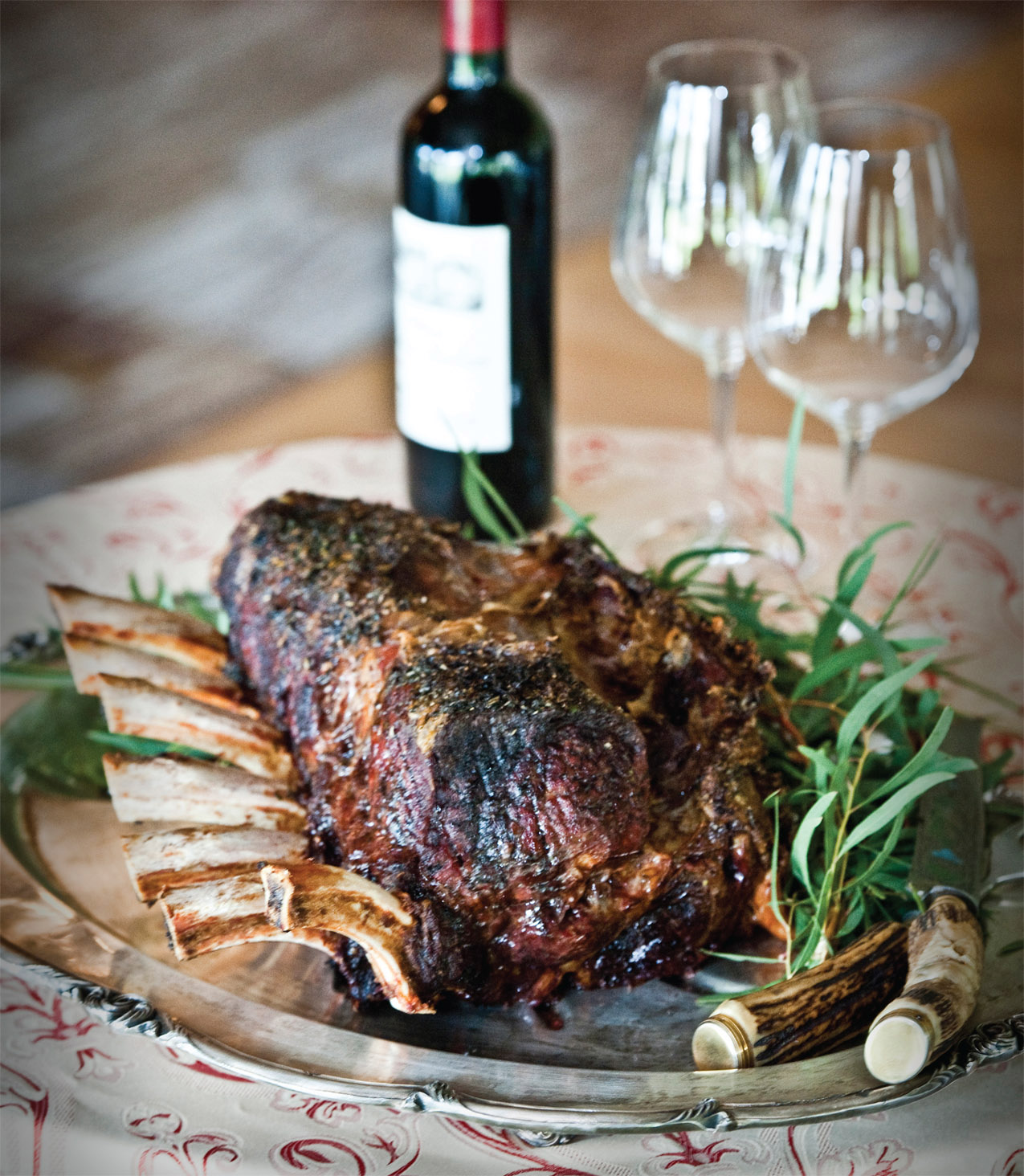

The most-ordered item on the Chico menu is afforded a striking presence on the plate with the bone-in effect that suggests a special occasion. The salty herb crust accents the marbled meat with savory goodness and cements this as a perennial favorite.
SERVES 8
Ingredients
1 bone-in prime rib
2 tablespoons olive oil
¼ cup kosher salt
½ cup chopped fresh parsley
¼ cup chopped fresh thyme
⅛ cup chopped fresh rosemary
⅛ cup chopped fresh sage
¼ cup chopped garlic
Instructions
Preheat oven to 450°F. Rub the prime rib with olive oil and season generously with kosher salt. Roast prime rib for 15 minutes, until golden brown. Take out of the oven and let cool to room temperature.
Mix herbs and garlic together and rub on prime rib. Set oven to 250°F. Roast prime rib another 2 hours, depending on the size, until it reaches an internal temperature of 120°F. Remove from the oven and let rest. The residual cooking while resting should bring the prime rib up to medium rare. For rare pull the prime rib at 110°F.
Slice and serve with Roasted Garlic Mashed Potatoes (recipe page 87) and Grilled Asparagus (recipe page 94).